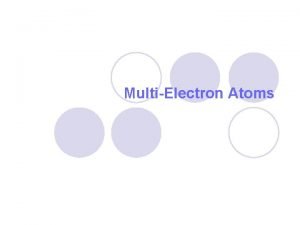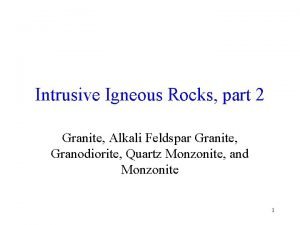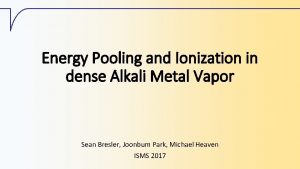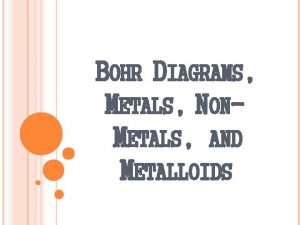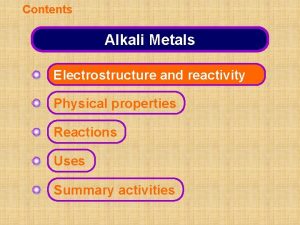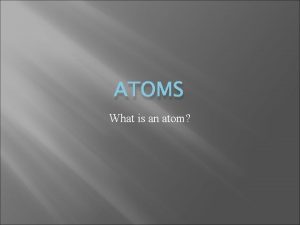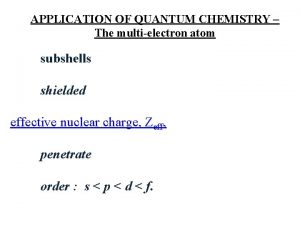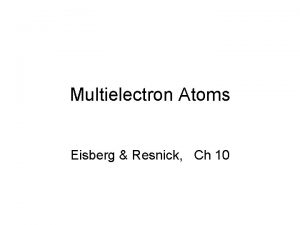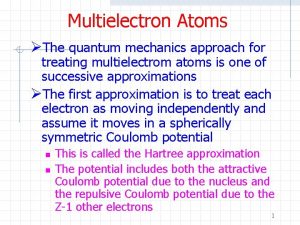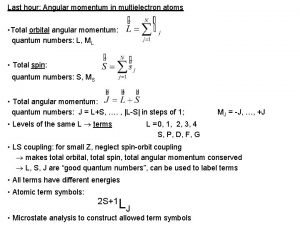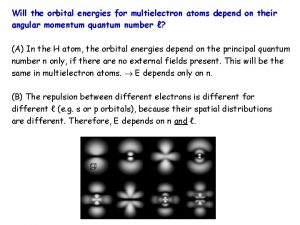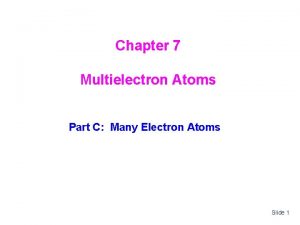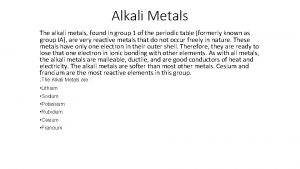Lecture 8 9 Multielectron atoms o Alkali atom


























- Slides: 26

Lecture 8 -9: Multi-electron atoms o Alkali atom spectra. o Central field approximation. o Shell model. o Effective potentials and screening. o Experimental evidence for shell model. PY 3 P 05

Energy levels in alkali metals o Alkali atoms: in ground state, contain a set of completely filled subshells with a single valence electron in the next s subshell. o Electrons in p subshells are not excited in any low-energy processes. s electron is the single optically active electron and core of filled subshells can be ignored. PY 3 P 05

Energy levels in alkali metals o In alkali atoms, the l degeneracy is lifted: states with the same principal quantum number n and different orbital quantum number l have different energies. o Relative to H-atom terms, alkali terms lie at lower energies. This shift increases the smaller l is. o For larger values of n, i. e. , greater orbital radii, the terms are only slightly different from hydrogen. o Also, electrons with small l are more strongly bound and their terms lie at lower energies. o These effects become stronger with increasing Z. o Non-Coulombic potential breaks degeneracy of levels with the same principal quantum number. PY 3 P 05

Hartree theory o For multi-electron atom, must consider Coulomb interactions between its Z electrons and its nucleus of charge +Ze. Largest effects due to large nuclear charge. o Must also consider Coulomb interactions between each electron and all other electrons in atom. Effect is weak. o Assume electrons are moving independently in a spherically symmetric net potential. o The net potential is the sum of the spherically symmetric attractive Coulomb potential due to the nucleus and a spherically symmetric repulsive Coulomb potential which represents the average effect of the electrons and its Z - 1 colleagues. o Hartree (1928) attempted to solve the time-independent Schrödinger equation for Z electrons in a net potential. o Total potential of the atom can be written as the sum of a set of Z identical net potentials V( r), each depending on r of the electron only. PY 3 P 05

Screening o Hartree theory results in a shell model of atomic structure, which includes the concept of screening. o For example, alkali atom can be modelled as having a valence electron at a large distance from nucleus. o Moves in an electrostatic field of nucleus +Ze which is screened by the (Z-1) inner electrons. This is described by the effective potential Veff( r ). o At r small, Veff(r ) ~ -Ze 2/r -e r +Ze -(Z-1)e o Unscreened nuclear Coulomb potential. o At r large, Veff(r ) ~ -e 2/r o Nuclear charge is screened to one unit of charge. PY 3 P 05

Central field approximation o The Hamiltonian for an N-electron atom with nuclear charge +Ze can be written: where N = Z for a neutral atom. First summation accounts for kinetic energy of electrons , second their Coulomb interaction with the nuclues, third accounts for electron-electron repulsion. o Not possible to find exact solution to Schrodinger equation using this Hamiltonian. o Must use the central field approximation in which we write the Hamiltonian as: where Vcentral is the central field and Vresidual is the residual electrostatic interaction. PY 3 P 05

Central field approximation o The central field approximation work in the limit where o In this case, Vresidual can be treated as a perturbation and solved later. o By writing we end up with N separate Schrödinger equations: with E = E 1 + E 2 + … + EN o Normally solved numerically, but analytic solutions can be found using the separation of variables technique. PY 3 P 05

Central field approximation o As potentials only depend on radial coordinate, can use separation of variables: where Ri(ri) are a set of radial wave functions and Yi( i, i ) are a set of spherical harmonic functions. o Following the same procedure as Lectures 3 -4, we end up with three equations, one for each polar coordinate. o Each electron will therefore have four quantum numbers: o l and ml: result from angular equations. o n: arises from solving radial equation. n and l determine the radial wave function Rnl(r ) and the energy of the electron. o ms: Electron can either have spin up (ms = +1/2) or down (ms = -1/2). o State of multi-electron atom is then found by working out the wave functions of the individual electrons and then finding the total energy of the atom (E = E 1 + E 2 + … + EN). PY 3 P 05

Shell model o Hartree theory predicts shell model structure, which only considers gross structure: 1. States are specified by four quantum numbers, n, l, ml, and ms. 2. Gross structure of spectrum is determined by n and l. 3. Each (n, l) term of the gross structure contains 2(2 l + 1) degenerate levels. 1. Shell model assumes that we can order energies of gross terms in a multielectron atom according to n and l. As electrons are added, electrons fill up the lowest available shell first. o Experimental evidence for shell model proves that central approximation is appropriate. PY 3 P 05

Shell model o Periodic table can be built up using this shell-filling process. Electronic configuration of first 11 elements is listed below: o Must apply 1. Pauli exclusion principle: Only two electrons with opposite spin can occupy an atomic orbital. i. e. , no two electrons have the same 4 quantum numbers. 2. Hunds rule: Electrons fill each orbital in the subshell before pairing up with opposite spins. PY 3 P 05

Shell model o Below are atomic shells listed in order of increasing energy. Nshell = 2(2 l + 1) is the number of electrons that can fill a shell due to the degeneracy of the ml and ms levels. Naccum is the accumulated number of electrons that can be held by atom. o Note, 19 th electron occupies 4 s shell rather than 3 d shell. Same for 37 th. Happens because energy of shell with large l may be higher than shell with higher n and lower l. PY 3 P 05

Shell model o 4 s level has lower energy than 3 d level due to penetration. o Electron in 3 s orbital has a probability of being found close to nucleus. Therefore experiences unshielded potential of nucleus and is more tightly bound. PY 3 P 05

Shell model Radial probabilities for 4 s 3 d 4 s - red 3 d - blue Note: Movies from http: //chemlinks. beloit. edu/Stars/pages/radial. htm PY 3 P 05

Shell model Radial probabilities for 1 s 2 s 3 s 1 s - red 2 s - blue 3 s - green PY 3 P 05

Shell model Radial probabilities for 3 s 3 p 3 d 3 s - red 3 p - blue 3 d - green PY 3 P 05

Quantum defect o Alkali are approximately one-electron atoms: filled inner shells and one valence electron. o Consider sodium atom: 1 s 2 2 p 6 3 s 1. o Optical spectra are determined by outermost 3 s electron. The energy of each (n, l) term of the valence electron is where (l) is the quantum defect - allows for penetration of the inner shells by the valence electron. o Shaded region in figure near r = 0 represent the inner n = 1 and n = 2 shells. 3 s and 3 p penetrate the inner shells. o Much larger penetration for 3 s => electron sees large nuclear potential => lower energy. PY 3 P 05

Quantum defect o (l) depends mainly on l. Values for sodium are shown at right. o Can therefore estimate wavelength of a transition via o For sodium the D lines are 3 p 3 s transitions. Using values for (l) from table, => = 589 nm PY 3 P 05

Shell model justification o Consider sodium, which has 11 electrons. o Nucleus has a charge of +11 e with 11 electrons orbiting about it. o From Bohr model, radii and energies of the electrons in their shells are and o First two electrons occupy n =1 shell. These electrons see full charge of +11 e. => r 1 = 12/11 a 0 = 0. 05 Å and E 1 = -13. 6 x 112/12 ~ -1650 e. V. o Next two electrons experience screened potential by two electrons in n = 1 shell. Zeff =+9 e => r 2 = 22/9 a 0 = 0. 24 Å and E 2 = -13. 6 x 92/22 = -275 e. V. PY 3 P 05

Experimental evidence for shell model o Ionisation potentials and atomic radii: o Ionisation potentials of noble gas elements are highest within a particular period of periodic table, while those of the alkali are lowest. o Ionisation potential gradually increases until shell is filled and then drops. o Filled shells are most stable and valence electrons occupy larger, less tightly bound orbits. o Noble gas atoms require large amount of energy to liberate their outermost electrons, whereas outer shell electrons of alkali metals can be easily liberated. PY 3 P 05

Experimental evidence for shell model o X-ray spectra: o Enables energies of inner shells to be determined. o Accelerated electrons used to eject core electrons from inner shells. X-ray photon emitted by electrons from higher shell filling lower shell. o K-shell (n = 1), L-shell (n = 2), etc. o Emission lines are caused by radiative transitions after the electron beam ejects an inner shell electron. 80 ke. V 40 ke. V Wavelength (A) o Higher electron energies excite inner shell transitions. PY 3 P 05

Experimental evidence for shell model o Wavelength of various series of emission lines are found to obey Moseley’s law. o For example, the K-shell lines are given by where accounts for the screening effect of other electrons. o Similarly, the L-shell spectra obey: o Same wavelength as predicted by Bohr, but now have and effective charge (Z - ) instead of Z. o L ~ 10 and K ~ 3. PY 3 P 05

Bohr model including screening o Assume net charge is ( Z - 1 )e. o Therefore, the potential energy is o Total energy of orbit is o Modified Bohr formula taking into account screening. o Can therefore easily show that PY 3 P 05

Shell model summary o Electrons in orbitals with large principal quantum numbers (n) will be shielded from the nucleus by innershell electrons. Zeff = Z - nl. o nl increases with n => Zeff decreases with n. o nl increases with l => Zeff decreases with l. PY 3 P 05

Shell model summary o o o In hydrogenic one-electron model, the energy levels of a given n are degenerate in l: 3 s 3 p 3 d Not the case in multi-electron atoms. Orbitals with the same n quantum number have different energies for differing values of l. As Zeff = Z - nl is a function of n and l, the l degeneracy is broken by modified potential. PY 3 P 05

Shell model summary o Wave functions of electrons with different l are found to have different amount of penetration into the region occupied by the 1 s electrons. o This penetration of the shielding 1 s electrons exposes them to more of the influence of the nucleus and causes them to be more tightly bound, lowering their associated energy states. PY 3 P 05

Shell model summary o In the case of Li, the 2 s electron shows more penetration inside the first Bohr radius and is therefore lower than the 2 p. o In the case of Na with two filled shells, the 3 s electron penetrates the inner shielding shells more than the 3 p and is significantly lower in energy. PY 3 P 05
 Multielectron
Multielectron Regents periodic table
Regents periodic table Lowest allowable energy state of an atom
Lowest allowable energy state of an atom Electrons in atoms section 2 quantum theory and the atom
Electrons in atoms section 2 quantum theory and the atom 01:640:244 lecture notes - lecture 15: plat, idah, farad
01:640:244 lecture notes - lecture 15: plat, idah, farad The structure of the atom section 2 defining the atom
The structure of the atom section 2 defining the atom Berlawanan dengan model atom thomson model atom rutherford
Berlawanan dengan model atom thomson model atom rutherford Minyak masak neutral atau alkali
Minyak masak neutral atau alkali Common elements
Common elements Thalassemia
Thalassemia What's a chemical bond
What's a chemical bond Alkali cat
Alkali cat Which group is alkali earth metals
Which group is alkali earth metals Natrium klorida asid atau alkali
Natrium klorida asid atau alkali Alkali metals periodic table
Alkali metals periodic table Trend in melting points of alkali metals
Trend in melting points of alkali metals Nh fl mc lv ts og
Nh fl mc lv ts og Cara memperoleh alkali tanah
Cara memperoleh alkali tanah What color are alkali metals
What color are alkali metals Uses of alkali metals
Uses of alkali metals Minerals in granite
Minerals in granite Alkali metals periodic table
Alkali metals periodic table Alkali metals bohr diagrams
Alkali metals bohr diagrams General characteristics of alkali metals
General characteristics of alkali metals Siyah alkali toprak
Siyah alkali toprak Characteristics of alkali
Characteristics of alkali Alkali metals reacting with water
Alkali metals reacting with water
